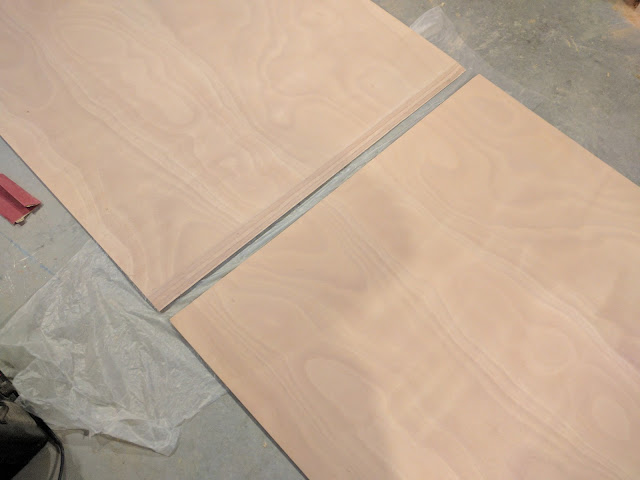 |
| Nested strakes make for lots of lines, hope they're right. |
I had four solid hours of time to myself today to work on the soon to be boat and made good use of my time. After working out a decent system for laying out the planks/strakes last night I got straight to work marking out the last two planks on the first scarphed panel. I was able to layout the remaining two planks in roughly an hour and forty five minutes which, compared to last nights three hour session, seemed like light speed. I spot checked a number of marks to make sure they were right and I'm fairly comfortable that I got all the measurements correct (cross fingers).
As I was finishing up I was thinking about how long it's going to take to get all of these planks cut when it occurred to me that after I cut these planks out I could use them as a pattern for the next scarphed panel. I suppose this revelation should have been obvious, but it wasn't to me. Then I thought, why not just cut both panels at once, then I get two of each plank matched exactly.
That brought me to the next question which was "how am I going to cut these planks?" I hadn't really thought too much about it before because I was focusing on getting the layout correct, and I didn't really think that I would be at that point today, but here I was. I had unconsciously assumed that I would use my jigsaw, but I have never been happy with the speed or the lumpy cuts I always seem to get because even a millisecond's inattention is enough to change the direction of the saw. I always cut proud of the line, but cleanup is always a chore.

That got me thinking about using my Bosch 7-1/4" circular saw to do the cuts. When I built the shop last summer, I spent a huge amount of time with that saw and I got really comfortable with it. The cut line gauge is really accurate and it doesn't wander like a jigsaw and as long as the radius isn't too deep, it can follow a curve nicely. Oh, and it is Way faster than a jigsaw.

The blade was pretty dull from the shop build, so I ran up to Home Depot and got a Diablo 60 tooth thin kerf blade, mounted it, and got busy.
I lined up two of the scarphed panels so the edges matched up, screwed them together with a few wood screws and started cutting. It took just under an hour to cut all the planks out with a few breaks in between to let the dust settle and I'm really happy with how they turned out. No oops, crap, or whatever; it just worked and worked well. Every edge is smooth and about 1/16" proud of the line.
 |
| Nice smooth cut, just proud of line. |
So, to make a long story short, I went from being overwhelmed with how much drudgery work I had to do, to having eight of the eleven planks cut out and nicely matched. I still have to mark out and do the same operation on plank number five and cut out a single keel strake, but I feel like I over the hump and may actually start making the wood look like a boat next week.
 |
| Can't even see that there are 8 planks; the benefits of stacked cuts. |
 So my fingertips are really sore from drilling and pulling almost 300 zip ties to get the hull, transom, and bulkheads stitched, but it's now done. Finally... It really wasn't too bad, and the sound of the zip tie 'zipping' up and pulling the strakes tight was pretty satisfying.
So my fingertips are really sore from drilling and pulling almost 300 zip ties to get the hull, transom, and bulkheads stitched, but it's now done. Finally... It really wasn't too bad, and the sound of the zip tie 'zipping' up and pulling the strakes tight was pretty satisfying.




























